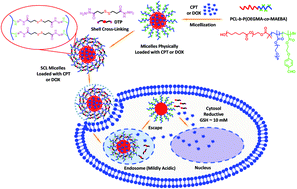Thiol and pH dual-responsive dynamic covalent shell cross-linked micelles for triggered release of chemotherapeutic drugs†
Abstract
We report on the fabrication of dynamic covalent shell cross-linked (SCL) micelles of amphiphilic

* Corresponding authors
a
CAS Key Laboratory of Soft Matter Chemistry, Department of Polymer Science and Engineering, Hefei National Laboratory for Physical Sciences at the Microscale, University of Science and Technology of China, Hefei, Anhui 230026, China
E-mail:
sliu@ustc.edu.cn
b
Key Laboratory of Functional Molecular Solids, Ministry of Education, Anhui Key Laboratory of Molecule-based Materials, College of Chemistry and Materials Science, Anhui Normal University, Wuhu, Anhui 241000, China
E-mail:
shzhluo@mail.ahnu.edu.cn
We report on the fabrication of dynamic covalent shell cross-linked (SCL) micelles of amphiphilic

 Please wait while we load your content...
Something went wrong. Try again?
Please wait while we load your content...
Something went wrong. Try again?
X. Hu, H. Li, S. Luo, T. Liu, Y. Jiang and S. Liu, Polym. Chem., 2013, 4, 695 DOI: 10.1039/C2PY20701J
To request permission to reproduce material from this article, please go to the Copyright Clearance Center request page.
If you are an author contributing to an RSC publication, you do not need to request permission provided correct acknowledgement is given.
If you are the author of this article, you do not need to request permission to reproduce figures and diagrams provided correct acknowledgement is given. If you want to reproduce the whole article in a third-party publication (excluding your thesis/dissertation for which permission is not required) please go to the Copyright Clearance Center request page.
Read more about how to correctly acknowledge RSC content.
 Fetching data from CrossRef.
Fetching data from CrossRef.
This may take some time to load.
Loading related content
